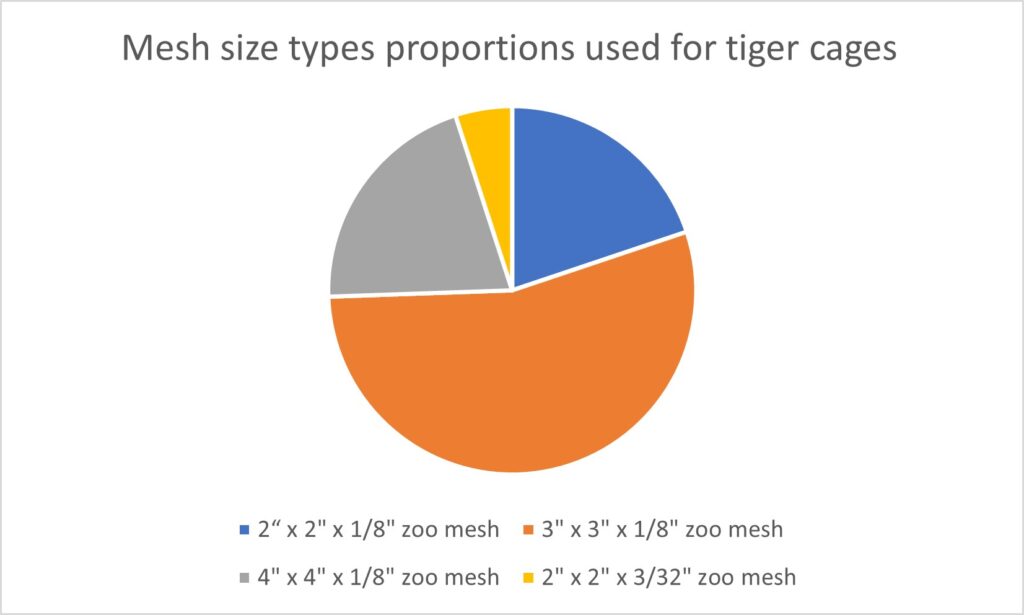Choosing the right mesh size for a tiger enclosure is crucial. It ensures the safety of both the tigers and the humans who interact with them.
This article aims to guide zookeepers, wildlife sanctuary personnel, and private exotic animal owners. It provides insights into selecting the appropriate mesh size for tiger enclosures.
By understanding the importance of mesh size, you can create a secure and comfortable habitat for these majestic creatures. Let’s delve into the key considerations for making the right choice.
Understanding the Importance of Proper Mesh Size
The mesh size of a tiger enclosure plays a vital role in safety. It prevents escapes and ensures containment of these powerful animals.
Incorrect mesh size can impact the health and stress levels of tigers. Too large, and they may attempt to escape or injure themselves. Too small, and it may restrict their view and natural behavior.
Industry standards exist to guide the selection of mesh size. These standards consider the welfare of the tigers and the safety of humans.
Choosing the right mesh size is a balance. It requires understanding the needs of the tigers and the practicalities of enclosure design.
Key Considerations for Mesh Size Selection
When selecting the mesh size for a tiger enclosure, several factors come into play. The first is the natural behavior of the tiger. Tigers are large, agile creatures with a strong instinct to hunt and explore.
The mesh size must be small enough to prevent them from escaping or reaching through. At the same time, it should not restrict their view or natural behavior. This balance is crucial for their well-being.
Consider the following when choosing a mesh size:
- Age and size of the tiger
- Enclosure design and layout
- Visibility for visitors
- Ease of maintenance and cleaning
- Legal requirements and guidelines
Remember, the goal is to create a safe, comfortable environment for the tiger while ensuring the safety of humans.
Industry Standards and Legal Requirements
Industry standards for tiger enclosure mesh sizes are set by accreditation bodies. These standards are designed to ensure the safety and well-being of both the tigers and the humans who interact with them.
Legal requirements for exotic animal enclosures also exist. These laws vary by location, so it’s important to consult with local wildlife authorities.
Failure to meet these standards and laws can lead to serious consequences. Always ensure your enclosure meets or exceeds these requirements.
Material and Durability Options for Tiger Enclosures
The material of the mesh plays a crucial role in the enclosure’s durability. Stainless steel is often the preferred choice due to its strength and resistance to weather conditions.
However, other materials like coated wire or chain link can also be used. The choice depends on factors like budget, local climate, and the specific needs of the tiger.
Remember, the material should be strong enough to withstand a tiger’s strength and prevent escape attempts.
Designing for Tiger Well-being and Visitor Experience
Designing an enclosure is not just about safety. It’s also about ensuring the well-being of the tiger. The mesh size should allow for natural behaviors like climbing and scratching.
At the same time, the enclosure should offer a good viewing experience for visitors. A mesh that is too dense can obstruct visibility. It’s about finding the right balance.
Remember, a well-designed enclosure can help educate visitors about these majestic creatures and the importance of their conservation.
Maintenance, Inspection, and Upkeep of Enclosure Mesh
Regular inspection and maintenance of the mesh are crucial. Over time, even the strongest materials can wear down or get damaged.
Routine checks help identify potential weak spots early. This allows for timely repairs, ensuring the enclosure remains secure.
Remember, the safety of both the tiger and the people around it depends on the integrity of the enclosure. Regular upkeep is a must.
26 years of scale analysis mesh size for tiger cages -Data from customers
Over the course of the past 26 years, we have diligently compiled and maintained a comprehensive database containing detailed information regarding the various types of mesh utilized in tiger enclosures. This data has been meticulously organized and recorded to ensure accuracy and accessibility for our valued customers. For your convenience, we have presented this information in an easy-to-read table format below.

| Mesh Size Types | Proportions used for tiger cages |
| 2″ x 2″x 1/8″ zoo mesh | 19.85% |
| 3″ x 3″x 1/8″ zoo mesh | 54.60% |
| 4″ x 4″x 1/8″ zoo mesh | 20.55% |
| 2″ x 2″x 3/32″ zoo mesh | 5% |
Conclusion: Balancing Safety, Welfare, and Costs
Choosing the right mesh size for a tiger enclosure is a delicate balance. Safety, animal welfare, and cost considerations must all be taken into account.
In the end, the goal is to provide a secure, comfortable habitat for the tiger while ensuring the safety of all involved.


